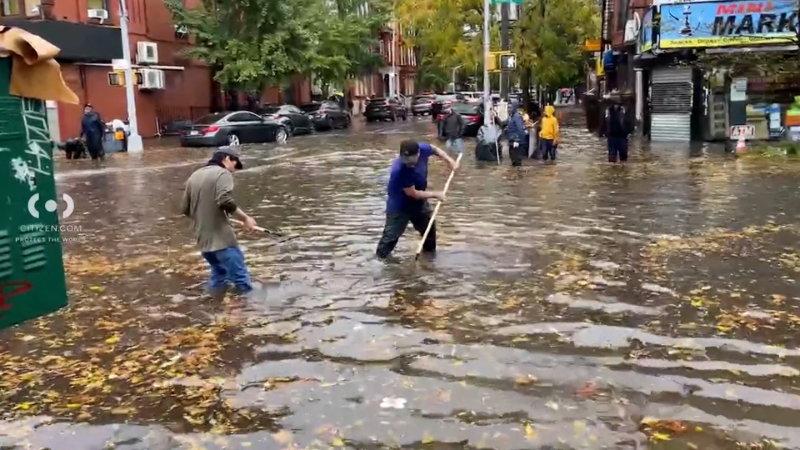Looking back at Hurricane Charley, the first in a 'nightmare' hurricane season for Florida
Hurricane Charley made landfall as a powerful Category 4 hurricane along the Florida Gulf coastline 20 years ago, after a sudden shift in track and intensity.

Hurricane Charley looms offshore from Florida on this satellite image from the morning of August 13, 2004.
Twenty years ago, on Aug. 13, 2004, before social media and the ubiquity of the iPhone, destructive Hurricane Charley made landfall as a powerful Category 4 hurricane along the Florida Gulf coastline.
Sudden shift in track and rapid intensification
The storm began in the Caribbean and moved northward toward Cuba. The initial thought was that it would weaken over Cuba, but it instead tracked west, staying over water and intensifying, AccuWeather Hurricane Expert Dan Kottlowski said.
The storm was initially expected to make landfall in the highly populated Tampa Bay area, but a last-minute shift in the track caused the center of the storm to make landfall farther south near Charlotte Harbor.
This shift caught many locals off guard. While the damage could have been much worse, the storm wreaked havoc in several Florida cities, including Fort Myers, Punta Gorda and Orlando.
Not only did the storm’s direction abruptly change, but the storm also rapidly intensified, strengthening from a Category 1 hurricane to a powerful Category 4 hurricane in only a few hours, Kottlowski said.
"Charley was a small but very powerful hurricane. The wind field around the hurricane was fairly small, with hurricane-force winds that were not more than 25 to 35 miles out from the center," Kottlowski said.

A radar loop shows Hurricane Charley making landfall on the afternoon of August 13, 2004.
Once making landfall, the storm unleashed an array of extreme weather. Several tornadoes touched down, wind gusts up to 140 mph caused significant damage and heavy rainfall sparked flooding. In all, Charley spawned nine tornadoes in Florida, five in North Carolina, and two in southeastern Virginia.
The powerful winds were the biggest threat to the cities, and caused most of the destruction. The winds knocked down power lines, trees, traffic lights, and signage throughout the cities. Many of the cities' residents lost part, if not all, of their homes, and some even lost their lives. Charley was directly responsible for at least 10 deaths in the U.S. It is estimated to have caused approximately $17 billion in damages.
"The hurricane acted more like a large tornado," Kottlowski said.

A car remains on a hydraulic lift Thursday, Aug. 26, 2004, in Punta Gorda, Fla., 14 days after Hurricane Charley leveled the service station around it.
"The tightly wrapped-up wind pattern around the storm allowed it to remain a hurricane as it tracked northeast and through the Orlando area during the evening of Aug. 13th."
Charley caused considerable wind damage to the Punta Gorda and northern Fort Myers area before tracking straight toward Orlando, where it caused a 25- to 50-mile-wide path of wind damage all the way to Daytona Beach along Florida's east coast.
Because Charley moved so swiftly over Florida, the storm didn't have time to weaken to a tropical storm. Charley remained a Category 1 hurricane when it exited the state over New Smyrna Beach and headed back out over the Atlantic Ocean.
Typically, inland communities are not often struck by hurricane-force winds with reported damage to trees, mobile homes and crops. About 2 million customers lost power in Florida and citrus farmers suffered $200 million in crop damage.

President Bush and Florida Gov. Jeb Bush are briefed by FEMA Director Mike Brown on the damage caused by Hurricane Charley at Charlotte County Airport in Punta Gorda, Fla. Sunday, Aug. 15, 2004.
After moving out of Florida into the Atlantic Ocean, the hurricane strengthened slightly as it accelerated toward the coast of South Carolina. This re-intensification was temporary. Charley came ashore again near Cape Romain, South Carolina, on Aug. 14, 2004, as a Category 1 hurricane. It continued to cause damage as it moved up the eastern U.S. coast.
The extensive storm damage led the World Meteorological Organization (WMO) to retire the name Charley in 2005. When a hurricane causes extreme damage or loss of life, the WMO removes the name from the rotating list of names used for Atlantic storms.
Charley was a warning shot for a 'nightmare' season
Charley was the first in a series of storms that hit the Florida coast in the 2004 season. Kottlowski described the year as a “nightmare” for the state in terms of tropical storms.

During the six weeks following Charley, Florida's 2004 hurricane season got much worse. Three more hurricanes moved through the state; Hurricanes Frances and Jeanne were only separated by 10 days.
Damage from Charley remained when the subsequent storms hit. Roofers were not able to repair every damaged home in time for the next three storms that moved through the state. News reports emerged that captured hundreds of homes covered by blue tarps to keep the rain from causing further damage. Some homes had blue tarps over them well into the following year, Kottlowski said.
Report a Typo














